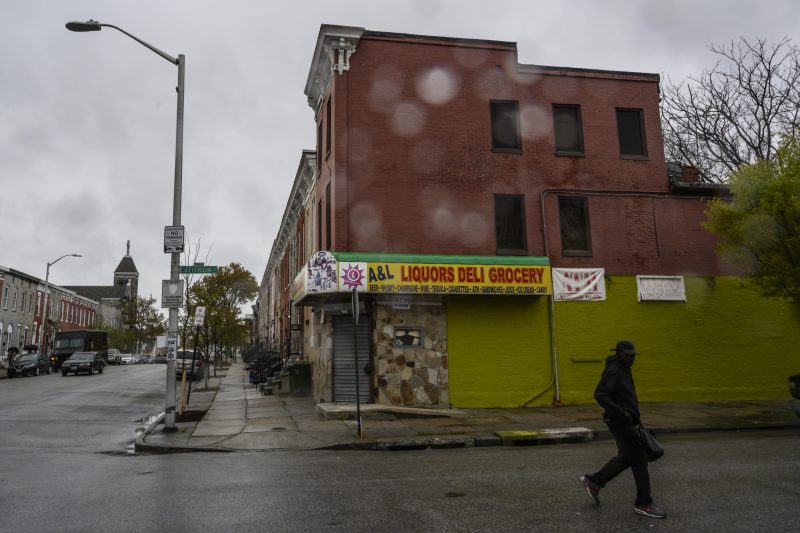Baltimore: a city stalked by violence, poverty and scandal
In Baltimore’s McElderry Park neighborhood, promised change never came — community association leader Dave Harris says a revitalization plan did not last (Eric BARADAT)
Baltimore (AFP) – Baltimore is known as Charm City, but these days, life here is anything but charming.
Violence, drugs and corruption have haunted the port city for decades, despite seemingly endless efforts at renewal.
Now, an investigation of the possible misdeeds of Democratic Mayor Catherine Pugh has added another layer of despair to the already grimy reputation of this city of 620,000 people.
A stroll through the streets of Baltimore reveals both the promise of possibility and the legacy of crime: in some neighborhoods, only a few streets separate condemned buildings from hip hotspots.
For many residents, exasperated by the city’s murder rate, hope is fading.
Dave Harris, president of the McElderry Park Community Association in East Baltimore, has encouraged his two sons, aged 18 and 25, to leave.
Just a few years ago, “the money poured in, we tried to invest and get things done, but the plan did not last,” Harris, 48, told AFP.
“Change did not happen because things were not built to be sustainable. It is now almost back to the way it was.”
His youngest wants to attend university elsewhere — “not too far away but outside,” Harris says.
Pugh, who has led Baltimore since 2016, is suspected of being paid about $800,000 for her self-published Healthy Holly books by companies and organizations with close ties to state and local government.
The veteran politician has gone on medical leave, but is standing her ground for now even as calls for her to resign have mounted.
Last week, the entire city council asked her to step down — in a one-paragraph memo.
– A tale of two cities –
Baltimore — the backdrop for many a television show and film, including the critically acclaimed HBO series “The Wire” — is proud of its picturesque Inner Harbor and its extensive aquarium.
But nearly a quarter of its residents live under the poverty line.
Once a major steel and manufacturing center, the city lost more than 100,000 industrial jobs from 1950 to 1995.
Baltimore is laboring to bounce back from the 2015 death of Freddie Gray, a 20-something black man who fell into a coma while in police custody and later died.
The anger that swept through the African-American community, which accounts for two-thirds of Baltimore’s population, towards a police force seen as racist and corrupt sparked protests and a night of riots.
Since Gray’s death, the city has become one of the most deadly in America, with an average of more than 300 murders a year.
So far in 2019, The Baltimore Sun has recorded 76 homicides.
– ‘Disgusted’ –
Monique Washington, president of the Edmondson Village Community Association in West Baltimore, can barely contain her anger.
“This has to stop. You can’t solve your problems through a gun,” Washington told AFP.
“I’m disgusted. I was once ready to sell my house, but I said no, because if the ones that really care leave, then we will really be through.”
Back in East Baltimore, Harris says after Gray’s death, “we tried to galvanize the youth, because their needs were not being met — lack of education, jobs, future, lack of everything.”
But the jobs did not come, and drug dealers reclaimed the streets.
Efforts to build police-community ties also faltered, he said, in large part due to the arrival of “officers from different cities who don’t understand how the city works.”
Last year, scandal rocked the city’s police force once again when corruption was unearthed in an elite task force that robbed residents, set up illegal searches and other abuses.
In March, the city’s former police commissioner was sentenced to nearly a year in federal prison for tax fraud.
Seema Iyer, a professor for the Jacob France Institute at the University of Baltimore’s Merrick School of Business, says there are “systems in our city that are not working harmoniously.”
She highlights the torpedoing of a major light rail line and other projects that would have given the city new life.
The east-west rail line “would have created jobs, development, increase in population, excitement!” she said.
“It was a huge death blow.”
– Glimmers of hope –
Iyer says some community programs begun in McElderry Park in 2014 — street cleaning, after-school tutoring, and workforce training among them — had borne fruit: the area was homicide-free for 500 days in 2015 and 2016, despite the post-Freddie Gray effect.
And downtown, the Lexington Market — an institution since 1782 — is a foodie’s paradise.
“City people are not millionaires — they are poor people,” says Fanny Houvardas, who has owned the Market Bakery for 45 years.
Her husband Mike adds: “Young people now want two-dollar cookies instead of a pound (of them), a slice of cake and not the whole cake.”
Disclaimer: Validity of the above story is for 7 Days from original date of publishing. Source: AFP.


